Mitigation analysis is a massive part of the risk analysis process, and Safran Risk makes it easier and less time consuming to conduct. It’s a huge improvement over OPRA, and this blog will explore why.
I’m Ian Nicholson, VP Solutions at Emerald Associates. I’ve been working with Oracle Primavera Risk Analysis (OPRA) since 2001 when it was called Pertmaster. Emerald was the exclusive Canadian distributor for Pertmaster until their acquisition by Primavera in 2006.
Mitigation Strategies
In part 5 of this series, I discussed entering risks and uncertainties in your risk model and then assigning them to the activities and costs that make up your risk model.
Once the model is built, and you’ve performed your risk analysis, your risk tool will tell you which risks are significantly impacting your model. The project team’s discussion should then turn to mitigation strategies.
You should be able to improve your chances of achieving your deterministic values for cost and schedule by focusing efforts on mitigating the risks at the top of the tornado.
Mitigation strategies may involve:
- Reducing the impact of a risk that does occur
- Avoiding a risk-reducing likelihood that the risk will occur.
- Transferring a risk to another party, through insurance or alternate contracting strategies
- Accepting the risk
Why is the 4th item even in our list? Well, we have to be realistic in our mitigation strategies. Sometimes, the cost of implementing any of the first three options make them financially unrealistic, leaving us to accept the risk as is. This doesn’t mean our efforts to identify the risk were in vain, since “forewarned is forearmed” and we’ve raised the visibility of the risk within the project team.
Incidentally, we should not forget that we need to maximize opportunities as well as mitigate risks.
Mitigating Risks in OPRA
Let’s assume that you want to include one of the first three options in the risk model. In OPRA, this can be done painlessly for risks, but not for uncertainties. This is because uncertainties have to be entered directly on the activities, a laborious process that’s prone to errors.
Additionally, OPRA does some frankly annoying things when conducting pre or post-mitigated model analysis:
- OPRA uses a ‘generate new file’ function to create both an additional pre and an additional post mitigated model which had to be saved somewhere. As the team evaluates various combinations and permutations of the model, this culminates in many large files filling servers and hard drives.
- If you make any changes to the generated model, the source model has to be updated manually, doubling the workload.
- It’s virtually impossible to generate a single model with some pre-mitigated and some post-mitigated positions.
- Mitigation costs are assigned to hammock activities that span the entire project duration. These then have to be placed in the appropriate project timeframe manually.
When working with OPRA and conducting a mitigation model analysis, it’s not unusual to be juggling 20 files with various pre and post mitigated what-if analyses. No matter how carefully you name them, you'll inevitably lose track of one or two and have to start on them from scratch. It can be a nightmare.
Mitigating Risks with Safran Risk
Safran Risk makes managing mitigation strategies much easier for the following reasons:
- You can store all risks and uncertainties in the Project Risks module (see part 4).
- Each risk and uncertainty can have a pre-mitigated and a post-mitigated impact and probability.
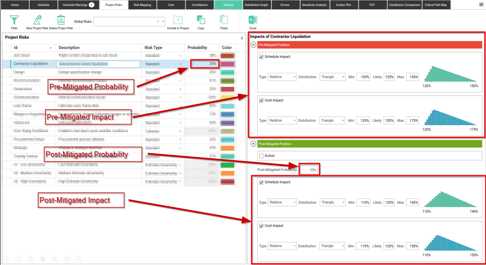
See full-screen imag
- The cost and additional duration of the mitigation strategy can be entered right onto the risk or uncertainty in the Action section.
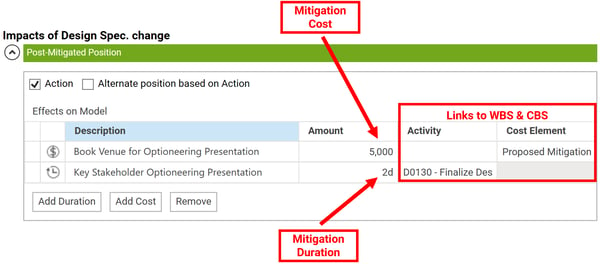
- You can model the likelihood of executing the mitigation strategy and the success of a mitigation strategy as an extra level of uncertainty in the model.
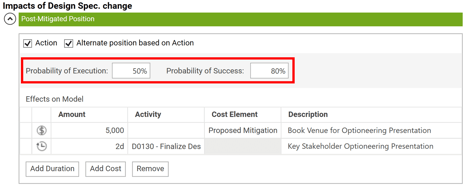
- On the Analyze tab, you can decide whether to use the pre-mitigated or post-mitigated position for each risk and uncertainty. This lets you build a model that reflects the real-world situation where some risks are in a pre-mitigated state and others are in a post-mitigated state. For me, this is the most significant improvement over OPRA: you can effortlessly create the combinations that the project team wants to evaluate in seconds rather than hours.
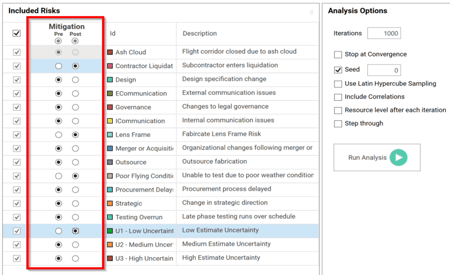
- You can turn an entire risk off. This lets you remove risks that you don’t want to consider in the model, either because you want to understand its effect on the model or want to show that excluding outliers has little impact on the overall model. This is useful also when the project team gets fixated on a risk that doesn’t show as having a large effect on the tornado diagram.
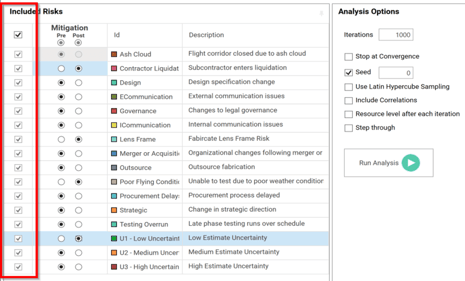
Mitigation analysis is a critical aspect of the risk analysis process, and Safran Risk makes performing this task painless and fast. There can be no doubt that, when it comes to mitigation analysis, Safran Risk is far more effective than OPRA.



